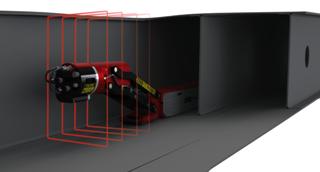Dec 8 2014
Oil & gas pipe measurement specialist Optical Metrology Services (OMS) has developed a non-contact, laser-based dimensional measurement system for aircraft wing boxes (horizontal stabilisers) and other similar shaped systems.
 Medium Head in Wing
Medium Head in Wing
Originally developed for a customer in the aerospace sector, the OMS Wing Box CHECKER measurement system is unique but can be engineered to meet specific customer requirements. The customer approached OMS because it required a system that could accurately measure the internal profile and size of wing box sections designed for a commercial aircraft. Made from a special carbon fibre composite, these wing box sections are complex in shape, with tapered ends and are split into multiple internal sections/compartments. These sections taper down to 100mm x 100mm at the smaller end. In addition, the measurement system had to be capable of measuring the corner radii of the box wing sections, which are absolutely critical as these are stress concentration points. The customer required a system that could internally profile four 12 metre long cavities inside the wing sector within a time period of four hours.
Using expertise gained from the development of similar automatic internal weld scanning tools for measuring the dimensions and profiles of welds in oil and gas pipes, OMS completed the design of the Wing Box CHECKER system within 4 months.
The Wing Box CHECKER is a rugged system made from high grade aluminium. The system comprises a tractor unit, automatic lifting/extension arms, three interchangeable sensors/measuring heads, a separate controller and a launch skid. The three sensor heads are interchangeable units that are mounted to the system as the wing box tapered section gets smaller. This was the only way of ensuring that a single measuring tool could access all the required internal sections of the wing box.
The tracked vehicle is driven by a DC servo motor geared drive and timing belt. The tractor unit, which can move forwards or backwards, has a self-centering mechanism for alignment in the cavity. This mechanism ensures that the tool is kept on the wing box centreline in three axes (x, y and yaw) at all times – which it acheives by utilising three laser displacement sensors.
The extension arms are powered by an electronically-driven linear actuator. The three sensor heads incorporate laser profile scanners that provide a measurement accuracy of +/- 0.254mm and up to 2,048 measurement points digitally filtered to 600.
Data output is provided in the form of an SA point cloud for scans and Microsoft Excel for radii and flanges. The angle of the tool to gravity is also reported in one or two axes. Profile data can be transferred to a PC via the umbilical cable and can be data logged to a PC hard drive. All tool commands are controlled via a PC keyboard/mouse and software interface. The Wing Box CHECKER is powered by a low voltage DC power supply via an umbilical cable.
Hugh Davies, Client Solutions Director at OMS comments: “Our mix of mechanical, electrical and software integration skills at OMS enabled us to engineer a complete measuring system for the customer. The real challenge was the shape of the wing box sections and devising a single system that was capable of performing all the measurements within the alotted time period [one hour]. Because of our experience working on oil & gas pipeline projects, we were able to offer all the necessary design, manufacturing and software integration skills that were required on this project.”